Moscow hosted a conference of Patterns & Practices Summit

On Monday, September 13, on the day of the programmer, the Patterns & Practices Summit conference was held. The event took place in the center of Moscow at the Holiday Inn on Lesnaya.
For those who are not in the subject, it is worth explaining what Patterns & Practices is. As the largest developer of software development platforms, Microsoft by all means helps developers build effective solutions on their platform. To do this, Microsoft creates software development guides for various platforms, for example, SharePoint, Windows Phone 7, or for specific tasks, such as guidelines for creating parallel applications in the .NET environment. In addition to manuals, Microsoft releases developers' tools in the form of code libraries and other material: laboratory work, realistic demonstration projects, video courses.
')
Most of the material with recommendations for building applications in Microsoft is developing a group called Patterns & Practices. This group explores best practices in building application architecture, writing code, creating numerous manuals and libraries (for example, the Enterprise Library known to many .net developers). From the pen group constantly go and publish books.
Thus, the Patterns & Practices Summit event is another step Microsoft takes in trying to share its experience and best software development practices with Russian developers. Reports at the conference were read by the developers from the Patterns & Practices group.
The conference
Patterns & Practices Summit in Russia is held for the second time. This year, the reports were read in two streams and broadcast live on the Internet through Smooth Streaming technology. Thus, anyone could see the conference by logging onto the pnpsummit.ru website.
The conference was opened by the President of Microsoft in Russia Nikolay Pryanishnikov and the company's partners. Unfortunately, due to the delay in the aircraft, I was late for the opening and found only two news announcements: RZD, together with Microsoft, launches its school of developers and Net App presented its products on the Microsoft platform.
The first at the conference were two plenary reports from Euhinjo Pace (Senior Program Manager in the Microsoft P & P team). Then the flows of reports were divided by topics: the first topic was the actual practice of building efficient software, and the second - cloud computing and scenarios of their application.
Below is a complete list of reports:
Patterns & Practices:
- Microsoft Enterprise Library 5.0;
- SharePoint 2010 application models;
- Building flexible modular Silverlight and WPF applications using Prism;
- Teamwork practices in Microsoft Visual Studio Team System.
Cloud computing scenarios:
- Architectural scenarios of cloud applications;
- Dynamic data centers for organizing a private cloud;
- Integration of various types of clouds with Windows Server AppFabric and Azure AppFabric;
- The scenario of building a dynamic IT infrastructure management system.
Impressions and details
Start
As I already wrote, due to the delay of the plane, I was late for the conference for about forty minutes and did not find any welcome speeches. But he managed on key reports from Euhinhio Pace. Pace talked about how his team works at Microsoft, how they plan to release new manuals, what priorities they set and what to expect from the Patterns & Practices team in the near future.
Pace noted especially that for them the key to success is working with the community, and therefore they try to release new material as often as possible, about once every two weeks.
On these reports, the hall was packed to capacity; in general, the conference was a full house. Interestingly, most of the public was quite young, although I expected to see a large number of company executives or software architects, it seems that most of those present were ordinary developers.
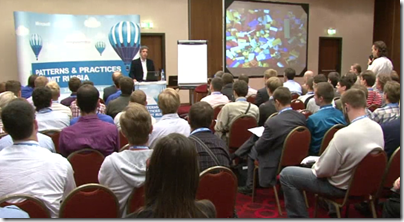

Immediately after the key report, Pace read the second report on the design of applications for Windows Azure. During the report, an example was considered with some scalable blog that is hosted in the cloud. Pace reviewed the basic requirements for such a project, showed which parts of Windows Azure can solve certain problems during the implementation of the project. In general, from scratch described the process of designing a cloud service with an emphasis on detail.
It was interesting, but, unfortunately, for obvious reasons, time constraints, the project description was not accompanied by code examples. And I would like to see the design of a real project. But, instead of this, Tailspin, a realistic application developed for Windows Azure for educational purposes, was demonstrated. A guide to creating this project can be read online at this address .
Dinner
After the keynotes that Pacea read, a dinner was held where hungry developers and other participants could easily communicate with each other. Here I must say that for me personally, such events are important precisely to communicate with colleagues and new acquaintances. Visiting various events you can meet and communicate with different people.
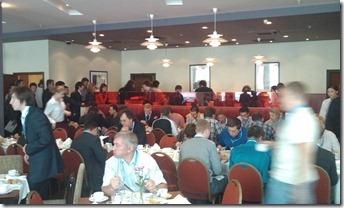
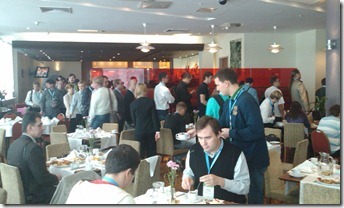
Lunch (rather a buffet table) was held at the level, I think no one left hungry. After talking, it's time for the second part of the conference
The second part, Enterprise Library 5.0
After lunch, the conference was divided into two streams, which took place simultaneously in two halls. The first reports were reports about Enterpise Library 5.0 and architectural scenarios of cloud applications. I, like many, chose the first stream in order to listen to Grigor Melnik, who has long been working in the Patterns & Practices group. Despite the fact that Gregory speaks Russian, he read the report in English, citing the fact that his working language is English and all the terminology of the report, too. There was barely enough space for this report, the hall was packed.
The report was very interesting. For those who are not in the subject, Gregory told what an Enterprise Library is, what the purpose of this library is, and what parts it consists of. Then, on a five-minute example of writing real code, Gregory added logging support to the application using EntLib.

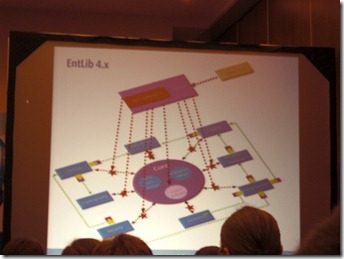
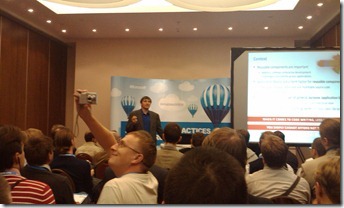
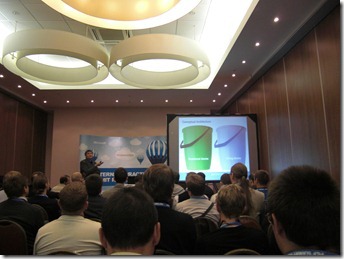
Later, a lot of material was submitted about the library: links within components, the role of Unity, the philosophy of the library, the ability to use individual components and the use of third-party libraries to work with the Enterprise Library. It was told about the internal changes in EntLib 5.0 compared to 4.0. About why in the fifth version there were no new functional blocks.
Gregory turned out to be a great live speaker, he joked a lot, sometimes he was fascinated and began to talk very quickly because of what he himself sometimes experienced difficulties. In general, I personally rated this report as five.
Data Center and Private Clouds
The next reports were reports on SharePoint and dynamic data centers. I chose the second topic. In the course of the report, Andrey Beshkov and Sergey Orlik in turn told about the software and hardware architecture of private clouds. It was interesting to know Microsoft’s vision for the future of data centers.
The speakers talked about Microsoft's initiatives to create a standardized private cloud architecture, about the Windows Azure Appliance program. At the end of the report, a short video was shown about the Microsoft data center and standardized standardized containers with servers and their architecture. In general, the report turned out to be rich in information, especially for me far from building data centers and server technologies.
AppFabric
The next conference reports were the Prism framework and AppFabric servers. I chose the second topic because it was more interesting for me to learn something completely new. The report was simultaneously told by Alexey Fedorov and Dmitry Martynov. The theme of the AppFabric application server is quite complex and it was not easy for an unprepared listener, like me, to understand all the details.
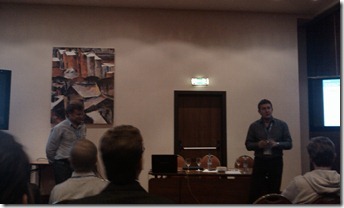
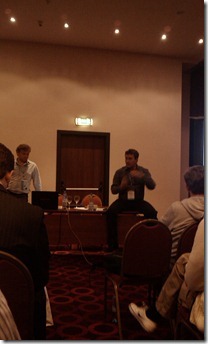
During the report, they talked about what Windows Azure AppFabric is, how it differs from the Windows Server AppFabric, what parts of both technologies consist of, what are they used for. The main topic of the report was an emphasis on the integration of information flows within a heterogeneous corporate environment using AppFabric and Windows Azure. Little has been affected by the BizTalk server.
Q & A session
The latest conference reports were teamwork reports using Visual Studio 2010 and building dynamic IT infrastructure management systems. But due to the fact that by this time, communication with colleagues reached a maximum, I did not go to the reports, I preferred them to communicate on the sidelines and over a cup of coffee.
But we all went together to the question and answer session, which ended the conference. The session was attended by all the speakers and visitors could ask them questions on the topics of the conference. Questions were asked different and not always on topics. For example, someone was interested in the fate of Visual C ++, which, compared to .NET and C #, did not receive such wide support in Visual Studio 2010. Others asked about private clouds and the possibility of using them in specific scripts. One developer offered his software developments to the PnP team and asked how to share them ... In general, there were a lot of questions.
I got the impression that this session, namely the opportunity to immediately ask a group of experts from Microsoft is one of the most significant parts of the conference.


Conclusion
In general, I was pleased with the conference, although a number of minuses could be noted that I would like to see in the future as advantages.
First, although the whole stream was devoted to cloud technologies and much was said about Windows Azure, no one explicitly announced when to expect the appearance of Azure in Russia. Will we have data centers, what plans does the company have regarding the development of cloud technologies in our country? There were no clear answers. Even when, during breaks, I was directly interested in the speakers, the answers were vague: “we are working on it” and “there are plans for cloud development in Russia”.
Secondly, there were few new, exclusive content in the conference topics. In general, if you rummage through the Internet, go to MSDN, buy books, read manuals, then almost everything that was at the conference can be found by yourself. It is unfortunate that during this event there were no announcements that would allow us to remember the PnP Summit as something exceptional. I would like the Microsoft PnP team not only to talk about what has already been released, but also to provide us with something completely new, for example, plans for a parallel development guide for C ++ (work on it started quite recently).
However, for those who are looking for not similar information from such events, but communicating with colleagues, we can confidently say that the conference was a success. I managed to see a lot of old and not very familiar people, pull out Microsoft employees and ask them about different things. Much more new can be found not on the reports, but in the intervals between them. Therefore, taking this opportunity, I would like to recommend to everyone and everyone to visit conferences more often. Especially such as Patterns & Practices Summit, where you can meet professionals who rarely come to our region.
PS
It should be noted that at the conclusion of the conference, visitors were given two excellent books: “Guidelines for designing application architecture” and a completely new book, “Developer's Guide to Enterprise Library”, which has not yet been sold, and its circulation is limited - only 1000 copies. This surprise was very pleasant, which will leave memories of the conference for a long time.
Source: https://habr.com/ru/post/104281/
All Articles